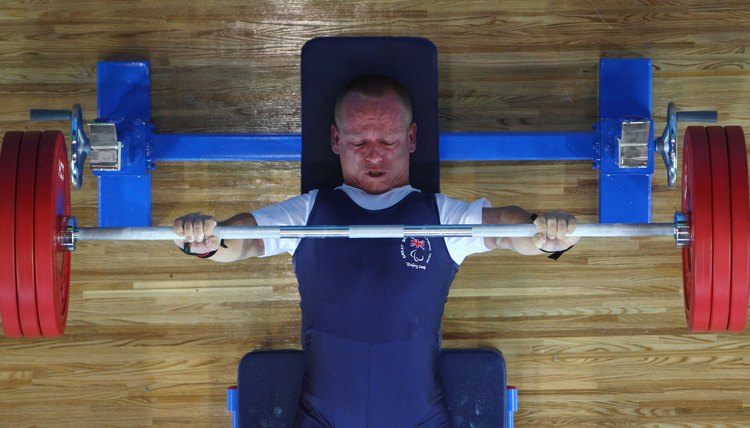Masters Athletes & Training for Powerlifting

Powerlifting comprises three lifts -- the squat, deadlift and bench press. In competition, you get three attempts at each lift, and your best score for each one gets added together to make your total. Whoever has the highest total wins. To make competitions fair, participants are divided into categories -- juniors, open, which is sub-divided into weight classes, and masters. In most federations, lifters 40 years of age and above qualify for masters. While the training for masters lifters largely echoes that of anyone else, you do need to make small adjustments.
Starting Powerlifting
If you're new to powerlifting, masters competitor Bill Duncan, holder of a 523-pound squat and deadlift, recommends attending a few meets first, to watch a competition in action. If you've not lifted weights since high school, then your perception of powerlifting may not be completely accurate. Duncan also advises training at a suitable gym -- you don't necessarily need a specialist powerlifting one, but your gym should have squat racks, Olympic bars, bench press stations, deadlifting platforms and plenty of weights. Without these, you won't be able to train properly.
General Programming
Masters competitors should follow the general powerlifting training principles. Divide your training into three phases. Each phase should last four to six weeks. The first phase is accumulation, where you use light weights for a high number of repetitions, concentrating on form and technique. Four to five sets of 10 reps on each exercise works well here. The second phase is transmutation, where you start lifting slightly heavier weights, and reducing the number of sets and reps. Training sessions are harder, but you should still avoid training to failure. The final phase is the realization, where you aim to set new personal records on all your lifts. This can be draining, so keep the workout volume low but the intensity high. Finally, take two weeks to deload, where you lift light weights and take easy training, before starting another accumulation phase, using slightly heavier weights than before.
Exercise Selection
You need to train the three competition lifts -- squats, deadlifts and bench presses -- but the rest of your training exercises are up to you. Accessory movements, such as front squats and box squats to aid regular squats, glute ham raises and block pulls for deadlifts, and overhead presses and chin-ups for bench presses, can all be used to increase strength on your main lifts, but you need to be careful with your choices. As you get older, chances of injury increase. So you should avoid higher-risk exercises, such as behind the neck pulldowns and presses, leg extensions and good mornings. You may also want to include more rehabilitation-type exercises, such as face pulls, glute bridges and core work to keep your muscles and joints healthy.
Considerations
Masters lifters take longer to recover between training sessions, says elite masters competitor Roger Broeg of the powerlifting website CriticalBench.com. Therefore, you may need to scale down the frequency, volume or intensity of your sessions if you're feeling sore or burnt out. You might also benefit from more frequent deloads -- once every three to four weeks or so, instead of every 12 to 16, and recovery strategies such as sports massages, stretching and ice baths. Nutrition is an important consideration too. The U.S. Department of Agriculture recommend that highly active males and females over 40 eat between 2,400 and 2,800 and 2,000 to 2,200 calories per day respectively. As you're putting your body under the stress of training, you may need more than this. Start at these figures and increase your intake gradually if progress is stalling or you're not recovering between sessions.
References
- Powerlifting Watch: Starting at Middle Age: A Few Tips for the Beginning Master Lifter-Parts 1 & 2: Bill Duncan
- EliteFTS: A Practical Guide for Implementing Block Periodization for Powerlifting: Gabriel Naspinski
- Critical Bench: Powerlifting for the Master Lifter: Roger Broeg
- U.S. Department of Agriculture: Dietary Guidelines for Americans 2010
Writer Bio
This article was written by the CareerTrend team, copy edited and fact checked through a multi-point auditing system, in efforts to ensure our readers only receive the best information. To submit your questions or ideas, or to simply learn more about CareerTrend, contact us [here](http://careertrend.com/about-us).
